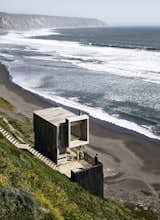Purple thistles, California poppies, clover, and dandelions have all taken root in the roughly 10-inch-deep, lightweight humus and grape-husk soil in this 580-square-foot green roof. Designer Peter Liang says that he "wanted to plant a green roof for its thermal mass, but I wanted it to be as natural as possible."
New Depths
Inspired by a local winery, George Kyprianou wanted a glass top on his subterranean wine cellar. The interior is lit, casting soft light into the living space at night and revealing the 132-year-old stone foundation. The three-quarter-inch glass lid sits flush with the floorboards; it opens with an ingenious device that Kyprianou devised using a 12-volt air compressor and a remote-controlled switch. When you push the button, the glass lifts just enough to be removed by hand.
As the facade of a Bates Masi-designed home in Water Mill, New York, rises from eight to 14 feet high, the mahogany planks subtly widen. “It was quite a demand to make of the contractor,” architect Paul Masi says. “But the design was so much about traveling through the site and weaving [the house] together with the deck.”
Fed up with flashy, environmentally insensitive beach homes, architect Gerald Parsonson and his wife, Kate, designed a humble hideaway nestled behind sand dunes along the New Zealand coastline. Crafted in the image of a modest Kiwi bach, their 1,670-square-foot retreat consists of a group of small buildings clad in black-stained pine weatherboards and fiber-cement sheets.
Light Box
Peter created a simple uplight at the top of the wood box by wiring together energy-efficient fluorescent fixtures typically used under cabinets and countertops. “The cheaper magnetic models hum unacceptably loudly, so make sure you get the electronic ballast types,” he warns. He then painted the cavity white to reflect light and covered them with quarter-inch-thick acrylic from TAP Plastics.
homedepot.com
tapplastics.com
The Jorgensen's Menlo Park home is a model of green design with features that are smart for everyone to consider. "Every project is different, but there are some universal things that will apply from project to project," says Feldman about designing a green home. "The first—and most obvious thing—is to always try to build less, to have a smaller house and be smart about how the rooms are designed and oriented so that you can get by with less space. Smart design will lead to a smaller building, but it won't feel smaller."
23k more photos


























![As the facade of a Bates Masi-designed home in Water Mill, New York, rises from eight to 14 feet high, the mahogany planks subtly widen. “It was quite a demand to make of the contractor,” architect Paul Masi says. “But the design was so much about traveling through the site and weaving [the house] together with the deck.”](https://images2.dwell.com/photos/6063391372700811264/6133555113391534080/original.jpg?auto=format&q=35&w=160)








